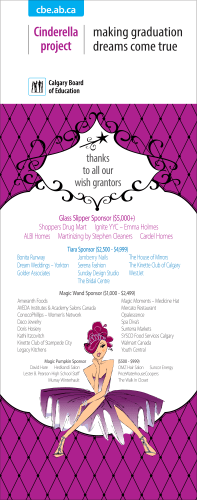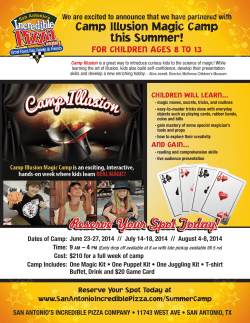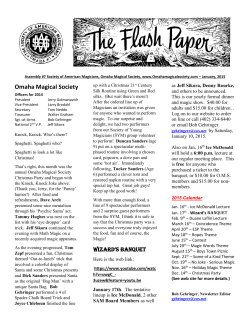
Science of Magic - Amazon Web Services
RESOURCE GUIDE This resource guide is designed to be used in conjunction with the live performance of Bill Blagg’s Science of Magic show. Utilizing the resources in this guide will help you explore the wonders of magic with students. You will be able to further your students’ understanding of the art of magic and the scientific principles/processes displayed in Bill Blagg’s Science of Magic show. The goal of this guide is to further promote students to think “outside the box” and spawn their curiosity about how science is used to create the impossible! Resource Guide The Man Behind the Magic To say that Bill Blagg has had a magical life would be no exaggeration. From the moment he received his first magic kit in 1985, his world was never the same. Bill professionally launched his magic performing career in 1996, at the ripe age of sixteen. Bill became a stand-out in the magic community, due in part to his off-the-cuff personality and his high-energy performance style. After graduating college with honors, Bill hit the road to perform magic full-time. Today, Bill has one of the largest touring illusion shows in the country. His show has been featured on NBC, CBS and FOX television. Having a love for both magic and science, Bill combined the two to create his one-ofa-kind, educational show called The Science of Magic. The show takes students on a rare, exciting, never-before-seen journey behind the scenes of the magic world. Students discover firsthand how magicians utilize science to create the impossible. Bill lives in Milwaukee, WI, with his wife Kristin. When he’s not performing he can be found at his workshop, working with his dad to create new illusions to thrill his audiences with. Magic & Science Both magic tricks and science experiments can leave people scratching their heads in amazement. Sometimes it seems there’s not much difference between magic and science. What are magic tricks anyway? Magic tricks are really just illusions. The magician knows the secret of how to do the trick. However, to the audience the trick looks like magic because they don’t understand how the trick was done. Many magic tricks are really just simple science experiments. The magician adds a few magic words and makes you believe that something supernatural and mysterious is happening. Magicians are master showmen and work very hard to fool audiences by using misdirection and manipulating their senses. In the end, there’s a scientific explanation for how the trick works that has nothing to do with magic or magic words. www.billblagg.com 1 Resource Guide Examining Magic The fascination with tricks and illusions is universal and timeless. Before you can examine magic in detail, it is helpful to let children discover the broadness of the topic. As you are introducing magic to the group, brainstorm all the different types of activities that might fall under the category of magic. Making things disappear, appear and change form is described as magic. Seeming to defy the “natural” order of the world (i.e. defying gravity, walking through walls) is called magical. Moreover, amazing feats that stun or surprise us are deemed “magical.” You may soon find your list of magic acts getting quite lengthy! Next it is helpful to look at some synonyms for magic. Illusions, tricks, stunts, and deceptions are all used to describe magic acts. Discuss with the children why something might be called a stunt, whereas something else is an illusion. Decide how broadly you would like to define the category of magic. Work with the children to create a working definition for the topic of magic. Pre-Show Discussion Topics Use the following questions to start classroom discussions prior to attending The Science of Magic: What is MAGIC? Name some famous magicians. What is your favorite magic trick? Does anyone know how to do a magic trick? If you could learn how to do one magic trick, what magic trick would you like to learn? Why? Do magicians have magical powers or do they use science to fool us? Where do magicians learn how to do magic? www.billblagg.com 2 Resource Guide Post-Show Discussion Topics Use the following questions for classroom discussion after attending The Science of Magic: How do magicians create magic tricks? They use the steps of the scientific method. They develop a theory (hypothesis) then they test it. If it fails they change one variable and test it again. They repeat this process over and over until they get their theory to work. Do magic tricks always work? No. Just like scientists, magicians must keep experimenting to find ways to make illusions work. Some ideas NEVER work and others take YEARS to create! How do magicians use mirrors to make magic? They use mirrors to reflect light to make a person think they are seeing something (a mirror image) that is not really there. What type of mirror did Bill use to make things disappear in the magic box? Plane mirror Can a solid pass through a solid? No. When molecules are tightly packed together they form a solid. In a solid the molecules can’t move or separate in order to allow another solid to pass through. Since a solid can’t scientifically pass through another solid, how did Bill pass through the rings through each other? Bill used misdirection and controlled the audience’s perspective on the rings to create the illusion of him passing one ring through another. What can you do with an object when you find its center of gravity? Make it balance After everything Bill taught us during the show do you think (teacher’s name) was really floating in mid-air at the end of the show? Mention the passing of the metal hoop as proof of no supports, etc. Use this question to spawn creative methods of how the teacher was floating. Activity: Create experiments to test the student’s hypotheses on how they think the teacher floated. Were their hypotheses correct? Why or why not? www.billblagg.com 3 Resource Guide Terms Illusion: something that produces a false impression of reality Misdirection: focusing attention on one thing in order to distract attention from another Perspective: the way objects appear to the eye Levitate: to float in air Center of Gravity: the point where the effect of gravity on an object is equal Magnetism: the invisible force that causes items to attract or repel each other Attract: to come together Repel: to push apart Mirror: an object with at least one reflective surface Mirror Image: the image seen when looking into a mirror Plane Mirror: a mirror with a flat surface. Most common type of mirror Reflection: the bouncing of light from a surface Refraction: the change in direction of light as it moves from one transparent substance to another Matter: anything that has mass and takes up space Atom: a tiny particle that all matter is made of Molecule: forms when atoms bond or link together. Density: a term used to compare two substances that occupy the same amount of space but have different amounts of matter Solution: mixing two or more substances together (salt water) Scientific Method: the process used to prove or disprove a hypothesis using experimentation. Hypothesis: an educated guess about the results of an experiment you are going to perform Experiment: a procedure used to test a hypothesis or to make a discovery www.billblagg.com 4 Resource Guide Magic Lesson 1: The Floating Egg Sometimes a magician seems to make things float in air. In this project you won’t make things float in air, but you will make an egg float in water. Materials Quart (liter) jar, tap water, scissors, ruler, masking tape, ½ cup salt, felt-tip pen, uncooked egg, large spoon The Setup 1. Fill the jar half full of water 2. Cut a 3” piece of tape and stick it to the outside of the salt container. Use the pen to write on the tape, “Magic Swimming Powder.” 3. Place the egg and spoon on the table Magic Science Time! 1. Tell your audience, “I am going to teach an egg how to swim.” 2. Begin by showing the audience that the egg doesn’t know how to swim by placing the egg in the jar filled with tap water. The egg will sink to the bottom. Remove the egg from the jar with the spoon. 3. Tell the audience that for the egg to swim you need to add magic swimming powder to the water. Pour the salt in the water and stir with the spoon. Say some magic words! 4. Place the egg in the water. The egg will float! Discussion How did the magic powder help the egg float? What was created by mixing the powder in the water? Why didn’t the egg float without the powder? Explanation All matter floats or sinks depending on its density. Less dense substances float on more dense substances. The egg floats in salt water because the egg is less dense than the salt water. However, the egg is denser than tap water, so it sinks. Salt water is a solution that contains both salt and water. A solution occurs when a solid is dissolved in a liquid. www.billblagg.com 5 Resource Guide Magic Lesson 2: The Broken Pencil In this trick you’ll use water and light to perform an interesting illusion. Materials A glass, tap water, pencil The Setup 1. Fill the glass about two-thirds full of tap water. 2. Place the glass of water and pencil on the table. Magic Science Time! 1. Hold the pencil in front of you. Tell the audience, “I am going to break the pencil by simply sticking it in this glass of water.” 2. Hold the pencil upright in the water so that the tip is about halfway between the surface of the water and the bottom of the glass. Make sure the pencil is near the back of the glass, away from the audience. 3. Move the pencil back and forth in the water, keeping it upright. Ask them what they see. It will appear as though the pencil is broken when in the water. 4. Remove the pencil from the water Discussion Did the pencil really break when it was placed in the water? If not, then why did it look like the pencil was split in half? Explanation This trick works because of refraction. Light travels in straight lines, but when it travels from one transparent substance to another the light rays bend. This is refraction. When light travels from a more dense transparent substance, such as water, to a less dense substance, such as air, the light refracts, or bends noticeably. Light travels at different speeds in substances with different densities. Light reflected from the pencil appears to the audience to be in one place when it travels to their eyes through the air, and in another place when it is refracted through water. www.billblagg.com 6 Resource Guide Magic Lesson 3: Disappearing Penny Here’s another effect that uses light and water to produce a mind-boggling effect. Materials Quart (liter) jar with lid, tap water, penny, helper The Setup 1. Fill the jar with tap water. Put the lid on the jar. 2. Place the jar and penny on the table in front of you. Magic Science Time! 1. Get a helper from the audience to assist you. 2. Have your helper examine the penny and confirm that it’s a real penny. 3. Have the helper place the penny on the table. Ask “Can you see it?” 4. Place the jar filled with water on top of the penny. 5. Say a few magic words and wave your hands over top of the jar. 6. Have the helper look through the water from the side of the jar and see if the penny is there or gone. What is the answer? Discussion Where did the penny go? Why can’t the helper see the penny through the clear water? Explanation When light travels from air to water, light bends toward the normal, a line perpendicular to the surface. Traveling from water to air, light bends in the opposite direction, away from the normal. This trick works because at a certain angle, when light travels from a more dense substance (water), to a less dense substance (air), it no longer refracts but will reflect. Reflection is the bouncing back of light from a surface. When the image of the penny comes toward the side surface of the jar at too great an angle, reflection rather than refraction occurs, and the image cannot be seen outside of the jar. www.billblagg.com 7 Resource Guide Magic Lesson 4: Keeping Dry Air can be used in many magic tricks. Try this trick to learn one way air can amaze! Materials Paper towel, drinking glass, plastic tub or bucket filled with enough tap water to reach the height of the glass The Setup 1. Place the materials on the table Magic Science Time! 1. Crumple the paper towel and place it in the bottom of the glass. 2. Turn the glass over and make sure that the paper will stay in place at the bottom of the glass. 3. Slowly lower the upside-down glass into the tub of water. Keep the glass as straight up and down as possible, until the entire glass is under the water. *Good time for discussion topic #1 4. Take the glass out of the water and let the water drip off the glass. 5. Turn the glass right side up and remove the paper towel. Let the audience feel the paper towel to determine if it is wet or dry. Discussion 1. Will the paper towel in the cup get wet? Why or why not? 2. Why didn’t the paper towel get wet when it was placed in the water? Explanation Air takes up space. The glass is filled with air when it’s right side up and when it is upside down. When you turn the glass over and slowly lower it into the water, air remains in the glass. The water cannot enter the glass because of the air inside the glass. The air creates pressure that is greater than the pressure of the water trying to get in. The towel in the top of the glass stays dry. If you were to tilt the glass on its side in the water, air would exit the glass and form bubbles. Water would then be able to enter the glass and soak the paper towel. www.billblagg.com 8 Resource Guide Additional Classroom Activities Here are some additional ideas to use in the classroom to further explore magic and science! Activity 1: Make Magic! Have students create their own magic tricks. Promote students to develop their own unique magic trick. Guide them through the steps of the Scientific Method to help them in their quest to create their very own illusion. If time is of the essence perform this activity as an all class magic trick. Ask students to share ideas of a magic trick they’d like to create. Select one idea and as a class follow the steps of the Scientific Method to make the trick a reality! Remember sometimes no matter how many times you try the trick won’t work. Be sure to document your experiments and the single variables you change each time. Use those notes to spawn classroom discussion on why the magic didn’t work. What else could be tried to make it work? Have students suggest other methods to try. Did they work? Activity 2: Magic Show! Have students select a magic trick from a magic book in the library. *If you’re school library doesn’t have any magic books find some magic tricks online to hand out to the students. See credits/resources at the end of this guide. Discuss with students the importance of showmanship when performing magic. Encourage them to use magic words, hand gestures, etc. when performing. Instruct the students to practice the trick at home. Plan a day to have the students perform their very own magic show. Following each trick explain the science that allows the magic to happen. www.billblagg.com 9 Resource Guide Credits / Resources Many of the tricks in this guide were adapted from the references below. Books Wiess, Jim (1998). Magic Science: 50 jaw dropping, mind-boggling, head-scratching, activities for kids. San Francisco: Jossey-Bass Shalit, Nathan (1981). Science Magic Tricks. New York: Holt, Rinehart and Winston Web Links Card Trick Central – http://web.superb.net/cardtric This website has hundreds of card tricks. They are sorted by ability level and make it easy to find an appropriate one to try. Magical Youth International – http://magicyouth.com Magical Youth International is the youth program of the International Brotherhood of Magicians (IBM). Bill Blagg – http://www.billblagg.com Official website for Bill Blagg that includes tour dates, biography, videos, pictures and an e-mail group sign up form. Special Thanks Overture Center for the Performing Arts (Madison, WI) – Educational Series (2010). *Excerpts from the self-produced Overture Center Guide have been referenced in this resource guide. Simon Shaw – Shaw Entertainment Group. Great Barrington, MA www.billblagg.com 10
© Copyright 2025









